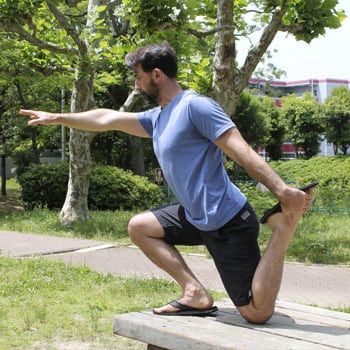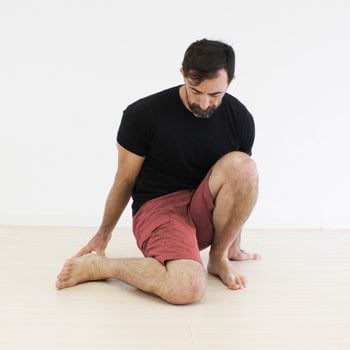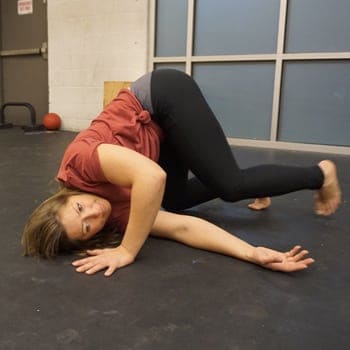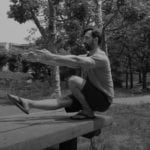You exercise for all sorts of reasons–to feel strong and flexible, to be healthy for the people who rely on you, or maybe to improve your performance in a favorite sport.
 But one often overlooked reason to exercise is to maintain and improve bone density.
But one often overlooked reason to exercise is to maintain and improve bone density.
Most women are aware from a fairly young age of the importance of maintaining bone density because women are at a higher risk for developing osteoporosis later in life. But emphasizing bone health is essential for men as well, and definitely should not be overlooked until it’s perhaps too late to make significant improvements.
In this article, you’ll learn how the right approach to bodyweight training can improve your bone health, and we’ll give you a fun routine with this emphasis.
Why Bone Density is a Big Deal for Everyone
 Bone density is one of those things we all know is important on some level, but we assume we don’t have to worry about until we’re older. And then, once we’re older, we assume it’s too late to do anything about it. Also, a lot of people think it’s an issue that only women have to worry about.
Bone density is one of those things we all know is important on some level, but we assume we don’t have to worry about until we’re older. And then, once we’re older, we assume it’s too late to do anything about it. Also, a lot of people think it’s an issue that only women have to worry about.
Well, let’s start by throwing all those assumptions out the window.
Everyone–men and women alike–experiences loss of bone density as we age, and we need to realize that process starts quite early. We reach peak bone density at around the age of 30, and we gradually lose bone mass from that point forward.
That might sound bleak, but it’s a natural process that can be impacted by external factors.
- If you build a higher level of bone density when you’re young, you’ll be in much better shape as you get older. You’ll still lose bone mass–again, it’s a natural process–but you’ll have more to lose while staying within healthy ranges.
- Even if you don’t start doing this proper weight bearing exercise until you’re older, you can still decrease your chances of experience bone loss severe enough to cause problems.
If your levels of bone loss are significant, it will cause problems as you get older.
The two most common bone loss related problems people face are osteoporosis (defined as having bone density levels 2.5 standard deviations below normal) and osteopenia (defined as having bone density levels more than one standard deviation below normal).
These both increase the risk of fragile bones, leading to wrist, vertebral, and hip fractures. Hip fractures, in particular, are a major cause of morbidity and mortality in the elderly. Falls resulting in fractures are unfortunately a common event that lead to cascading disability and loss of independence.
So let’s look at how to prevent this from happening!
How Bones Grow, and How Exercise Can Help
 First, let’s talk a bit about the general biology of it all.
First, let’s talk a bit about the general biology of it all.
- Cortical Bone–This is the outer layer of the bone. It’s very thin and hard, with a lot of nerve endings, and is what we would all recognize as “bone”.
- Cancellous Bone–This is the inner layer and contains the spongy framework and bone marrow that is the “active” part of our bones. The more flexible framework helps to distribute the various stresses and strains our bones undergo. This is a very important role that can’t be done as well if our entire skeletal structure were hard cortical bone. And also extremely critical here is the bone marrow which produces our blood cells.
- Osteoblasts–These are the “bone building” cells, that lay down the proteins and minerals necessary for bone growth.
- Osteoclasts–These are the cells that break down bone and are a necessary part of the cycle of remodeling and re-forming bone after injury as well as ongoing maintenance.
Each layer of bone and the cells within react to the normal stresses that we experience in our daily lives.
- Compressive Stress–This is when two things (in this case, bones) are pushed together.
- Torsional Stress–When the ends of bones are rotated away from each other.
- Tensile Stress–Stress that pulls the bones apart.
And we need these stresses! They stimulate proper bone growth and keeps us with healthy density. This is why astronauts require regular intensive exercise in space, otherwise their bone (and muscle) strength would deteriorate to very dangerous levels.
Fortunately, down here on Earth we have gravity to help us maintain our strength, but we also need to exercise beyond just walking around to counteract the losses brought upon by aging and inactivity.
Bodyweight Exercise Routine for Bone Health
While resistance training with weights is a great activity, you don’t need to train with weights to improve bone health. You just need sufficient and progressive load bearing exercise, which can be done with just your bodyweight.
The following routine is a good example of how bodyweight training can be ramped up in intensity to achieve the foces necessary to improve bone strength. It emphasizes loading your legs, hips, back, and arms with increased force from jumps and “drops.”
You’ll also be working on muscle strength (and the tendon/bone attachments) by controlling these forces in the “negative” part of the movement, the eccentric contraction of your muscles. In other words, you’re lowering your body under loads in a controlled way under higher and faster forces.
Start off easier with these movements by:
- Not going as far into an exercise range of motion
- Controlling the speed of the force
- Doing fewer repetitions
- Resting longer in between repetitions and in between sets
Performing this routine once or twice a week is enough because of the intensity of the force created by the movements, especially if you are already active in other training.
Let’s look at the exercises in detail.
Hop to Forward Lunge
 In this exercise, you’ll be doing a forward lunge but from a small hop. This increases the forces as compared to just starting from the regular starting position.
In this exercise, you’ll be doing a forward lunge but from a small hop. This increases the forces as compared to just starting from the regular starting position.
Start with a very small hop and increase the jump as you improve and get used to it. Again, you should be controlled and steady as you do the repetition. If you feel like you’re starting to lose control, then you’ve done enough repetitions.
Perform this for up to three sets of eight, with two minutes of rest in between sets.
Hop to Backward Lunge
 With this variation, you’ll hop back into a lunge position. You’ll notice a different sensation of force at your knees and ankles. Again, just as in the lunge forward, make sure your movements are controlled and steady.
With this variation, you’ll hop back into a lunge position. You’ll notice a different sensation of force at your knees and ankles. Again, just as in the lunge forward, make sure your movements are controlled and steady.
Perform this for up to three sets of eight, with two minutes of rest in between sets.
Hop to Side Squat
 Now, you’ll continue loading your legs and hips from a different direction as you drop down into a side squat. One detail here is to work on landing more onto the ball of your foot initially and then distributing your weight on to your entire foot.
Now, you’ll continue loading your legs and hips from a different direction as you drop down into a side squat. One detail here is to work on landing more onto the ball of your foot initially and then distributing your weight on to your entire foot.
You don’t have to drop down all the way at first, just do what you can. You can also take your time and use your hands to stand up again. The primary emphasis is on the controlled drop.
Perform this for up to three sets of six, with two minutes of rest in between sets.
Eccentric One Leg Squat
 The last lower-body and back exercise here is a single leg squat.
The last lower-body and back exercise here is a single leg squat.
You’ll notice in the video that it is performed by rising up onto the ball of your foot first, then dropping down into a squat on one leg. Again, you don’t have to drop all the way down, and even if you are comfortable, you should use your hands for balance, and reach and place them on the ground as you drop.
As you improve, you won’t need to do this as much. Also, you can stand up on both legs as needed.
Perform this for up to three sets of six, with two minutes of rest in between sets.
Fall Forward to Negative Push-Up
 This exercise loads your upper body and spine well, as you control your fall from kneeling into the push-up position.
This exercise loads your upper body and spine well, as you control your fall from kneeling into the push-up position.
Notice in the video how you can adjust your starting height and gradually increase the forces as desired. As you contact the ground with your hands, do so with bent elbows, as landing with straight arms can be too much for the elbow joints.
Perform this for up to three sets of eight, with two minutes of rest in between sets.
Eccentric One Arm Row
 This exercise is performed in the video using gymnastic rings, but you can do this at home with a broomstick or other strong support across two chairs or other similar setup.
This exercise is performed in the video using gymnastic rings, but you can do this at home with a broomstick or other strong support across two chairs or other similar setup.
Here, you’ll start at the top of a “rowing” position and shift over to one side as far as you can, then do a controlled drop. Pull yourself back up to the top position and repeat on the other side, alternating until your set is done.
Please, don’t fall hard onto your back! Your arms should either be straight with your back off the floor, or they can be slightly bent, stopping just short of the ground.
Perform this for up to three sets of six on each arm, with two minutes of rest in between sets.
Keep Your Body Healthy and Strong
 As you can see, bone health can be improved, and should be addressed at every stage of life–whether you’re a young man in his 20s or a woman in her 60s, it’s worth putting in the effort to keep your bones healthy and strong.
As you can see, bone health can be improved, and should be addressed at every stage of life–whether you’re a young man in his 20s or a woman in her 60s, it’s worth putting in the effort to keep your bones healthy and strong.
And the same is true of your overall health and fitness levels.
No matter your starting point, or what challenges you’ve faced in the past, it’s worth putting in the effort to improve the way you feel and move. And we’ve got just the place to start.
If you liked this routine, you’ll love our free Bodyweight Training Circuit, will help you start to build the foundation of strength, mobility, and overall control you need to keep your body (including your bones, of course) healthy and strong for as long as possible.


